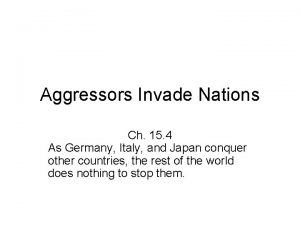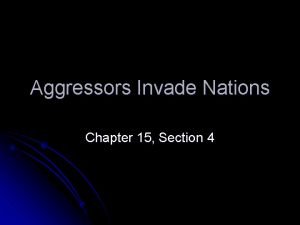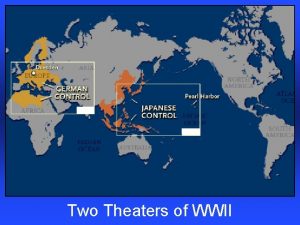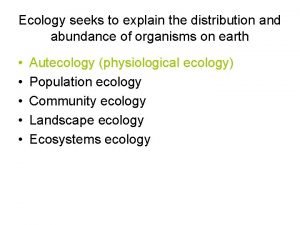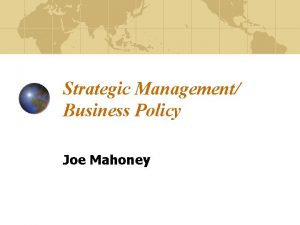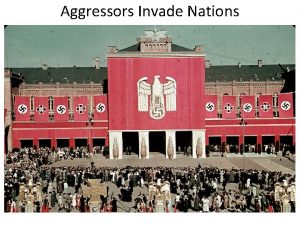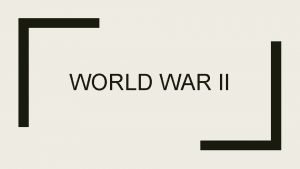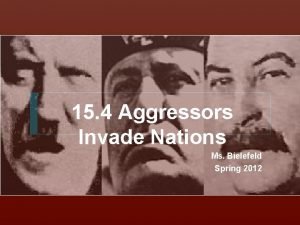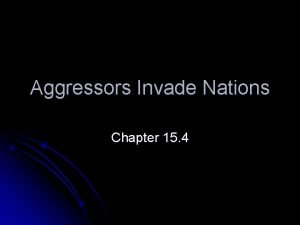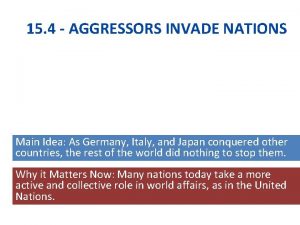Aggressors Invade Nations Japan Seeks An Empire Great














- Slides: 14

Aggressors Invade Nations

Japan Seeks An Empire • Great Depression allowed Military leaders take control of Japan – push emperor on the side again – Provide strong leadership during time of crisis – exactly what led to rise of militant fascism in Europe • Japanese leaders wanted to solve economic problems through expansion into the Pacific Wanted raw materials and markets for its goods – Japan in its new empire – Also give more room for its growing population – create new colonies – particularly in/most of China • 1931 - Japanese army seized Manchuria – Already had a foothold/leeway because of their victory during the Russo-Japanese War – Already invested in region due to iron and coal deposits – League of Nations protests action; Japan withdraws from League; League is powerless because the U. S. won’t intervene • 1937 - Japan launched war on China – Even though the Chinese had superior numbers, they weren’t as well trained/equipped to fight off the Japanese – Northern cities like Beijing, Nanjing fell – Japanese took and executed thousands of Chinese soldiers – At the same time, communist Rebel leader Mao Zedong led guerrilla fighters against the Japanese separately from the Chinese amry – Massacre/Rape of Nanjing – Tens of thousands of Chinese soldiers are executed and thousands of women are forced to become comfort women

The Nanking Massacre

European Aggressors On The • 1935 - Mussolini attacked Ethiopia. March – Ethiopia had been one of Africa’s free states that Italy had attempted to take in the 1800 s – Mussolini avenged the failure via poison gas, tanks, guns and airplanes – Ethiopian leader Haile Salassie appealed to the League of Nations, but they could do nothing but condemn it • 1936 - Germany invaded the Rhineland – buffer zone between France and Germany – By doing this, he broke the Treaty of Versailles where Germany agreed not to build up their army or take back lands it lost to other countries during World War I – Left Belgium and France open to attack – increased Hitler’s prestige • Britain urges Appeasement - policy of allowing aggression in order to keep peace – Namely, let Germany, Italy and Japan attack/expand where they want – Ironically, Hitler later admitted he would have stopped in the French and British challenged him then • Germany, Italy, and Japan form alliance – The Axis Powers – In October 1936, Mussolini and Hitler reached an agreement known as the Rome-Berlin Axis; later the agreement included Japan • League of Nations does not stop acts of aggression – does not have the political/military power to do so – U. S. didn’t sign the treaty – only country that could really enforce league

The Rhineland

Nations Try To Preserve Peace • Americans vote for Isolationism—avoidance of political ties with other countries – in this case Europe – 1935 - Congress passes Neutrality Acts – banned loans and sales of arms to countries at war • Hitler expands the Third Reich—German Empire (1933 – 1945) –Annexed Austria and Czechoslovakia – Italy took Albania • Appeasement shows Hitler and Mussolini that they can expand into different parts of Europe and Britain and France won’t do anything about it – continue to make concessions (dealing with economic problems from the Great Depression – Same for Japan in China and Korea – too far away and took resources they didn’t have • Britain and France try to get Russia to help them stop Hitler’s expansion – Russia also dealt with Hitler – leaders signed a non-aggression pact stating they would never attack each other in public • Italy, Germany and Japan are unopposed and war looms on the horizon

Third Reich (Germany; 1933 – 1945)

Germany Sparks a New War In Europe • Germany/USSR enter Nonaggression pact - Agree not to fight each other – Agreement includes secret deal to split Poland between them – Also stated that USSR could take over Finland, Lithuania, Latvia and Estonia • September 1939—Hitler invaded Poland in a surprise attack • German tanks and troop trucks rumbled across the Polish border in impressive numbers • German aircraft and artillery began a merciless bombing of Poland’s capital, Warsaw • In return, Britain/France declared war on Germany but Poland fell before any of the nations could take military action • Germans use Blitzkrieg —lightning war— Germany’s new military strategy –Used fast-moving planes and tanks; followed by massive infantry forces to take enemy defenders/overwhelm them –Poland was the testing ground for the strategy – worked remarkably well

Blitzkrieg

The Fall of France • May 1940—Germany conquered the Netherlands, Belgium, and Luxembourg in an effort to get to France – German army marched through the Ardennes, a wooded area in northern France, Luxembourg and Belgium • German army marched to French coast within 10 days of getting through the Ardennes- pinned British/French forces in Dunkirk – coastal city near Belgium – Pinned down by German military and aircraft via Blitzkrieg • Dunkirk Evacuation - British Navy/ civilian ships crossed the English Channel to rescue British soldiers –Rescued over 330, 000 soldiers – Tug boats, yachts, minesweepers, hospital carriers, lifeboats, motorboats, fishing boats, et. • Following Dunkirk, French resistance began to crumble ; By June 1940 Germany had taken Paris and set up a puppet government called Vichy • Charles de Gaulle - French general - Organizes opposition to Germany – Set up a government-in-exile in London – Organized Free French military forces to fight Nazis until France was liberated in 1944

The Dunkirk Evacuation “Miracle of Dunkirk” “Operation Dynamo”

Period 1 – Prehistory to 600 B. C. • From their origins in East Africa, nomadic humans slowly migrated across the earth, hunting and foraging for food • The development of farming (8, 000 B. C. ) marked the beginning of the Neolithic Revolution, where people began to settle by rivers/river valleys • Sedentary lifestyles led to the development of specialized skills, increased trade and bartering, and more complex forms of government • 4 River Valley Civilizations emerged: Mesopotamia, Egypt, Indus Valley, China • All civilizations developed writing systems, centralized authority into kingdoms, and developed social classes • Civilizations also developed distinct religious and cultural traits – introduction of priest/god kings (theocracy) • Development of bronze and, later, iron metallurgy (weaponry) spreads from civilizations as well as other goods – facilitates trade between them

• • • Period 2 – 600 B. C. /B. C. E to 600 A. D. /C. E The 1200 years between 600 B. C. – 600 A. D. saw the rise of great empires which became the core foundations for later civilizations Roman, Byzantine and Persian Empires were found in Western Eurasia, Maurya and Gupta in South Asia and Qin and Han China in East Asia Centralized empires provided security and stability – allowed for increased trade to flow overland via the Silk Roads, where goods (silk, perfume, porcelain, olive oil, etc. ) and ideas (Christianity and Buddhism) were exchanged Empires created bureaucracies to help administer the land road systems to facilitate communication/integrate territories Empires got so large that it became difficult to defend

 Aggressors invade nations chapter 31 section 4
Aggressors invade nations chapter 31 section 4 Aggressors invade nations
Aggressors invade nations Why was the munich conference unsuccessful
Why was the munich conference unsuccessful Chapter 15 section 4 aggressors on the march
Chapter 15 section 4 aggressors on the march Bat bomb
Bat bomb God is looking for true worshippers
God is looking for true worshippers India seeks self-rule
India seeks self-rule Africa seeks a better future
Africa seeks a better future Autumn is a season of mellow
Autumn is a season of mellow Population of earth
Population of earth Seek wise counsel scripture
Seek wise counsel scripture What passages in the poem explain why the seafarer seeks
What passages in the poem explain why the seafarer seeks Benchmarks are baseline values the system seeks to attain
Benchmarks are baseline values the system seeks to attain A transnational corporate-level strategy seeks to achieve
A transnational corporate-level strategy seeks to achieve How to enquire about admission
How to enquire about admission


